
 Scott
County, Tennessee
Scott
County, TennesseeFNB Chronicles

 Scott
County, Tennessee
Scott
County, TennesseeThe Oneida & Western Railroad
Edited by Josetta Griffith
For FNB Chronicle
In the early 1900s large tracts of land rich with virgin timber and coal lay in Pickett County, Fentress County, and the "Big Survey" which lay mostly in western Scott County. Because of the rugged terrain from which these resources had to be extracted, they were practically inaccessible.
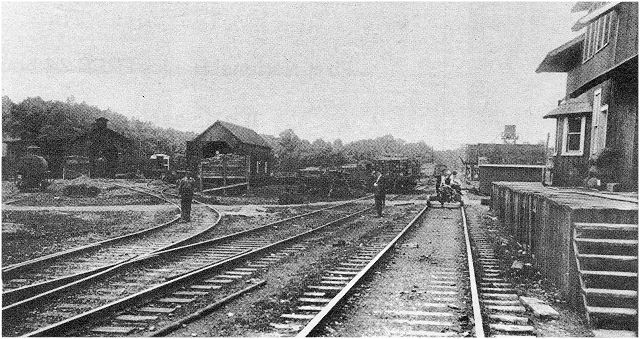 |
| The shop and depot area of the Oneida and Western Railroad in its heyday |
With little or no access to these prized natural resources, the Stearns Coal and Lumber Company, owner of the "Big Survey", tried various means to get the coal and lumber out of the remote reaches of this largely unpopulated gorge. Dumping logs over a 400 foot high cliff into the Big South Fork River to float to a dam built in Kentucky to catch them did not work (most of the logs sank!). A mill was built at Stearns, Kentucky and the company began buying up land from Lewis Bryant and building the Kentucky and Tennessee Railroad, which eventually reached into Fentress County, Tennessee.
A railroad from Elgin/Glenmary to Jamestown was talked about as far back as when Rugby was settled in the late 1800s. According to Elmer Sulzer, in Ghost Railroads of Tennessee (1975), The Jamestown Railroad Company was incorporated October 29, 1912 by the Tennessee Coal and Lumber Company at Glenmary for the purpose of constructing and operating a railroad from Glenmary to Jamestown. However, on August 5, 1913, the charter was amended, changing the name to the Oneida and Western Railroad Company, and authorizing the construction of a railroad from Oneida to Albany, Kentucky.
In Dusty Bits of the Forgotten Past, by H. Clay Smith, it was recorded, "the Glenmary mill was started in 1908 by the HAGEMEYER brothers, CHARLEY and C.C., and went by the name of Tennessee Coal and Lumber Company. The mill passed to CLIFFORD, HALL, and BARTLETT HAGEMEYER and their sister — all of Cincinnati, Ohio. These four sold interest in the Glenmary mill to take up interest in the Verdun mill of Tennessee Stave and Lumber Company."
BENITA J. HOWELL, in Big South Fork Folklife (1981) , records, "the Oneida and Western Railroad was owned and operated by O. H. ANDERSON, J. T. ANDERSON, HALL HAGEMEYER, BARTLETT HAGEMEYER, and W. C. ANDERSON. Others who were shareholders or bad related interests were WILLIAM RAY, D. M. SPECK, and WALES CHRISTIAN of Monterey, TN."
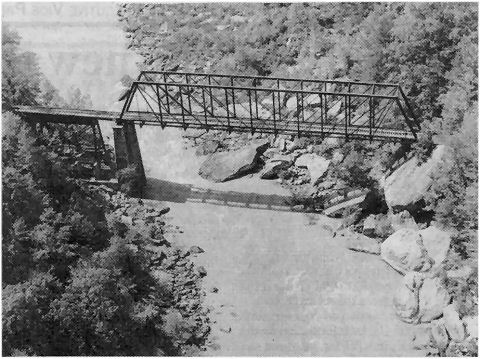 |
| Railroad bridge over the Big South Fork of the Cumberland River |
Construction of the O&W Railroad was hotly disputed by the Stearns Coal and Lumber Company in a law suit claiming that the O&W Railroad was being built without proper legal right to do so. Dr. FRANK C. THOMAS, retired president of the Stearns Company, remembers reading the document in which the Supreme Court of Tennessee ruled that the Stearns folk were correct. When the O&W owners planned construction of the railroad, they had no charter and really did not exist. However, the fact that the Stearns Coal and Lumber Company had brought legal suit against a company called the O&W Railroad, that action made it a corporate body and therefore, as of then, it did exist!
This could explain why the charter was amended on August 5, 1913, changing the name from Jamestown Railroad Company to Oneida and Western Railroad Company.
(Sulzer, 1975) "Construction started on the O&W Railroad in November, 1913 at Oneida and was completed to Bridge No. 6 near the Big South Fork River (10.2 miles) in June, 1915. Five more miles extended the line to Gernt in 1916. Another 3 miles was completed that year to Christian. It took 2 years to complete the 6.8 miles to Stockton. And, in 1921, the line reached 5 more miles into East Jamestown. A total of 30 miles."
Eagle Construction Company built part of the railroad, but most of it was constructed by O&W workers.
In 1921, the normal work day was 10 hours. Waterboys earned 15 cents an hour and section hands earned 25 cents an hour. The railroad created jobs for railroad workers, in addition to the jobs in the log woods, sawmills, and mines. The railroad opened one of the most prosperous booms ever in Scott County. It was also an important part of life for Fentress County.
The route of the O&W Railroad as it left Oneida ran beside Pine Creek, dropping steadily to the Big South Fork River. Once across the steel bridge that spanned the river, the railroad crossed White Oak Creek and began its climb to East Jamestown on top of the Cumberland Plateau.
|
|
|
| A coal tipple at Zenith on the Oneida and Western Railroad | The O&W Railroad Depot on Alberta Street in Oneida |
|
|
|
| "M-4" was the designation of this O&W Railroad Mail Bus | Jamestown’s Oneida & Western Railroad Depot |
Stations along the way included Verdun at 2 miles; Reed’s Station at 3 miles; Toomey at 6 miles; Speck at 13 miles; Potter at 14 miles; Gernt at 16 miles; Zenith at 17 miles; Christian at 19 miles; Briar Point at 20 miles; Hagemeyer at 21 miles; Stockton at 25 miles; and East Jamestown at 30 miles.
It is easy to see why it took 8 years to build the railroad through this rugged terrain. The "Big Cut’ between the Big South Fork River and Buck Ford was 90 feet high. A steam shovel was used for grading right of way, horse and mule teams did the hauling and pulled the "pan scrapers", hand cars on the completed rails brought in rail sections and tools, and a "rail dog" lifted the rails onto the hand-hewn cross-ties. Manual laborers included crews of colored men and even an Italian camp. Historian H. Clay Smith recorded that "REASON MARCUM, a law man of some 34 years in all, was one of the foremen who worked for A. M. COOK, the contractor in charge of building the railroad. It was his job to see that the Negroes did not try to run off. Then there were the other foremen: J. H. FLYNN and a Mr. HYDE, who
|
|
|
| A typical crew of Oneida & Western Railroad Train | |
|
|
|
| Officials pose with the engineer of the O&W Mail Bus | Construction is still underway on the O&W Railroad bridge across the Big South Fork of the Cumberland River in this old photo |
|
|
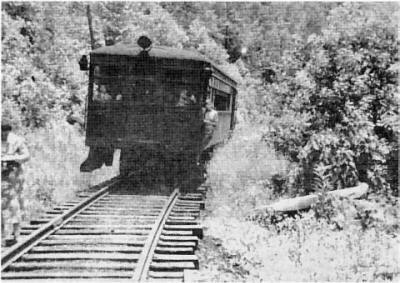 |
| One of the steam shovels used in construction of the O&W | Riding the Mail Bus of the O&W Railroad was a common practice |
were a bit rough and whom the black hated. These two went into the tent where several Negroes were gambling and opened fire on them. The latter fired back at the foremen and killed HYDE.
"The negro who did the killing escaped with his wounds as far as Oakdale, where he was shot and killed by the town police. His body was returned to Oneida and is buried on the CARL COLEMAN’s farm in West Oneida."
(Suizer, 1975)"Our country was deep in the First World War. The Oneida and Western Railroad deadheaded its one coach west 30 miles to East Jamestown, there to pick up twenty to thirty recruits and bring them back to Oneida for further transportation on the Southern Railway.
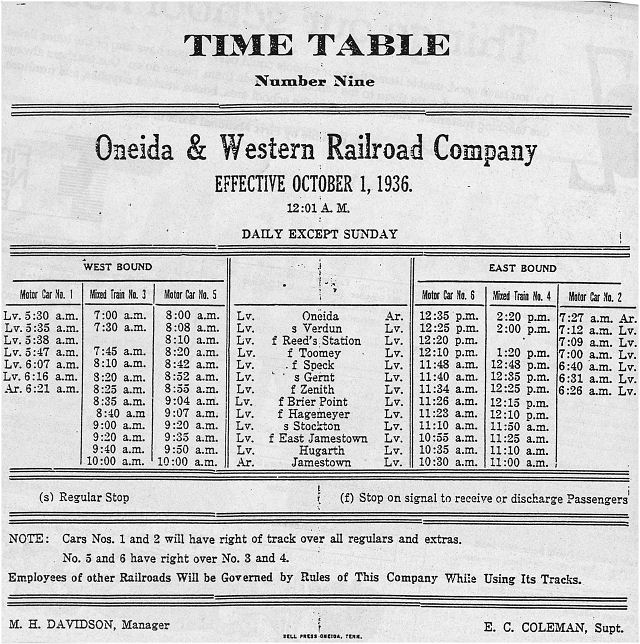 |
| Oneida and Western Railroad 1936 Time Table |
"WILLARD E. BOND, auditor for the O&W, accompanied the movement and lent whatever assistance would be needed. When the coach was loaded at East Jamestown he noted the passengers. To a man they were young natives of Fentress County, nervous and silent. Many of them had never been out of the county before, much less ridden on a train. The thought of fighting a war thousands of miles away on another continent was too much for many of these youths. They were plainly scared.
"Several years passed and the War was over. And one of the scared, silent youngsters was back home on his farm. He gave a picnic to which BOND was invited.
"The nervous unsophisticated recruit? "None other than ALVIN C. YORK, the courageous hero of World War I."
(Smith, 1985) "Logs from all the western parts of Fentress County and from Pickett County were pulled up a long incline and loaded on flatcars, to be shipped to the band mill at Verdun.
"The mill at Verdun, at one time, ran night and day cutting some of the finest timber in the state and shipping the product to the open markets."
|
|
|
| Oneida and Western engine No. 26 with Milford Acres as engineer. Standing at left are his wife, Eva Acres, and his son, Hoyal Acres. | |
|
|
|
| An O&W train chugs its way westward and crosses one of the several bridges which span creeks en route from Oneida to Jamestown | Scene of the Oneida & Western Railroad Company’s corporate office at the corner of Alberta and Depot streets in Oneida |
Several mine camps, section camps, and lumber operations sprang up between Oneida and Jamestown. The first of these was East Laurel which was a thriving camp in the 1920s. VIRGIE SEXTON’s dad, NEWTON WATTERS, ran a timber camp, cutting virgin timber in the vicinity of East Laurel. Newton Watters was born on April 13, 1875 and died April 18, 1970. He married Kate Crabtree , who was born on June 9, 1877, and died on January 24, 1945. They had nine children: PEARL, who married Fred Smith; MAUDE, who married a MARCUM; ARTIE; VIRGIE, who married MAXWELL SEXTON; MAXINE, who married HERBERT JEFFERS; CATHERINE, who married ZIEGLER BEETS; ARTHUR "Bud", who married BETSY BLEVINS; HILLARY; and WILLIAM HARVEY, who married a daughter of W. J. BLEVINS.
[The following was provided by Wendell Watters on 9 Nov 2009and did not appear in the original FNB article:
Newton Watters (b.1875 - d.1970) m. Kathryn 'Katie' Crabtree (b.1877- d.1945).
Moved from Gernt, TN to Yamacraw, KY on 7/26/1937.
Nine Children:
Walter b.1897, d. 1897
Pearl Mae, b.1898, d.1980, m. Fred L. Smith, Sr.
Vera Maude, b.1900, d.1997, m. Hillary Marcum
Arthur 'Bud', b.1903, d.1996, m. Bessie Blevins. 'Bud' was Scott County Road Supt.(1966-1974).
Artie, b.1903, d.1925, (Artie & Arthur were twins)
William Hillary 'Bill', b.1905, d.1949, m. Artie Blevins (dau. of W.J. Blevins)
Virgie Marie, b.1908, d.2002, m. Maxwell R. Sexton
Maxine Elliott, b.1911, d.1997, m. Herbert Jeffers
Kathryn, b.1913, d.2005, m. Zieglar Beets]
VIRGIE lived with her parents in the old boarding house at East Laurel for about 15 years. They took in a few boarders. The boarding house was a favorite stop-over for traveling salesmen and company officials. Her father took over the East Laurel Post Office around 1936. VIRGIE’s brother, Bud, also lived awhile at East Laurel. With the mines closed, it was pretty much deserted in the early 1930s.
To get eggs and groceries, VIRGIE remembers they went "on top of the mountain", which was to CHARLIE BROOKS’ store, and to Mount Helen. She remembers, too, the swinging bridge at Gernt.
When violence erupted at the Zenith mines in the mid-1920s due to labor unrest, VIRGIE’s mother insisted they move out from East Laurel and Mr. WATTERS went to work at Yamacraw, Kentucky.
On June 9, 1930, the O&W Railroad applied for permission to extend the line from East Jamestown, 7 miles into Jamestown. By now, the Tennessee Lumber and Coal Company owned the O&W Railroad and contended that the best timber had already been cut and the extension would allow for access to timber in the more remote area.
An article in the December 13, 1930 Scott County News reported: "O&W Extension into
|
|
 |
| Taking up steel in the O&W yard. Ziegler Beets and his daughter, Nancy Beets (now Williamson), who made several trips with her father. She has the bell seen in this photo. | An O&W train chugs its way westward and crosses one of several bridges which span creeks en route to Jamestown |
Jamestown will officially open Saturday, December 10, 1930." O&W officials listed in the news article were HALL HAGEMEYER, president; GEORGE JACKSON, superintendent; CARL COLEMAN, auditor; and A. M. COOK, local contractor. The article read as follows: ‘The officials of the Oneida and Western are to be commended for their attitude in building up this section of the country and giving these people an outlet by rail for their lumber, coal, farm products, poultry and other resources. Jamestown is planning for a celebration and a big day on the official opening of the road into their town, by means of which they will be linked up to the outside world by rail."
In spite of this extension to Jamestown, though, the advent of automobiles took its toll on passenger service of the railroad. Rail freight service was also meeting competition from trucks that were now able to pass over the new highways and bridges constructed in the early 1930s.
Violence at Zenith continued with gunmen shooting high powered rifles from the bluffs at workers walking along the railway.
(Howell, 1981) "In 1937, CASPER "Cap" WOODS, store manager for Webb Hammock mines, was ambushed and killed somewhere around Armathwaite. An extensive manhunt with bloodhounds was directed by Sheriff WOLFORD SMITH, who in a cast himself from a stray bullet during a previous altercation, proved ineffective. No firm case could be made against any of the suspects, some of whom were union organizers."
One of the outside union organizers implicated in the killing of CAP WOODS near Zenith returned to the mine camp after he was released from jail. He was walking along the railroad tracks drunk and stepped in front of an oncoming locomotive. The engineer was powerless to prevent the death of the pedestrian.
BROMMA PEMBERTON recalled her father, JOHN PARNELL, worked at Zenith in the mines during the time of the labor unrest. His family begged him not to go down to Zenith, but Mr. PARNELL felt obliged, on the company’s behalf, to go. JOHN PARNELL, his son, BILL PARNELL, and TAFT FAIRCHILD were shot at by riflemen as they walked to work, but none were injured.
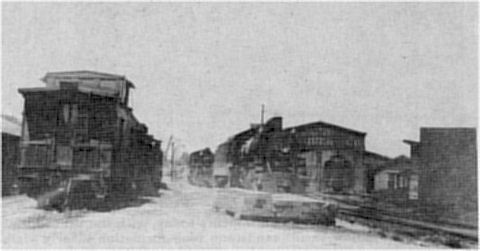 |
The O&W Shop scene in Oneida |
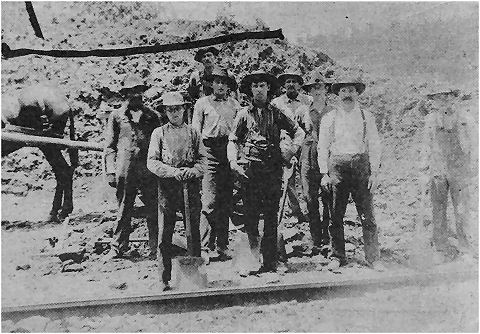 |
A railroad construction crew at the site known as the "Big Cut". This photo was provided by Mike O’Neal, formerly of Scott County, and now of the Tullahoma community. He is looking for the identity of the men in the work crew. Anyone with information can contact Josetta Griffith at First National Bank (423) 569-8586 or call the Independent Herald (423) 569-6343. |
MILFORD ACRES remembers first-hand how it was to work on the O&W Railroad. He began as a part-time waterboy while he was going to school. At that time the rail was laid as far as Buck Ford. He then worked as a brakeman, fireman and, until the O&W Railroad closed in 1954, he worked in the shop at Oneida.
MILFORD was hurt only once – he was brakeman and the train car he was on jumped track – he jumped off over an embankment onto some rocks and "stove up" his ankle.
|
|
| With a full head of steam and puffing its way down the track, an O&W engine pulls into one of the several stations on the route from Oneida to Jamestown. |
|
|
| No. 27 sits idle on the Onedia and Western Railroad yard in Oneida, waiting for another trip westward to Jamestown. |
WILLIE DOUGLAS worked for 36 years for the O&W Railroad as waterboy, fireman, brakeman, and engineer. According to a 1978 article in the Independent Herald, WILLIE fired the first engine ever to run the 38-mile course between Oneida and Jamestown. And he fired the last engine that ran in 1954. Before Mr. DOUGLAS’ death, he tracked down some of the 12 locomotives used during the life of the O&W. Number 29 was on the Walker College Campus in Jasper, Alabama; Number 20 was running on a 26-mile tourist road in Bella Falls, Vermont; Number 28 was at Hagarth, Mississippi. The oldest engine to run on the O&W was built in 1899. According to DOUGLAS, two of the best engines were twins, meaning they were both manufactured at the same time and had consecutive serial numbers. They were built in May 1902 by Alco-Pitts and were first used by Southern before being sold to the O&W. All the engines were "used" engines except No. 20, which was built in 1916 and bought brand new.
AUDNEY ACRES was engineer on the last train that ran for revenue on March 4, 1954. The conductor was WILLIE MASSEY, George Parnell was fireman, and HARRISON TERRY was brakeman. According to H. CLAY SMITH, the last train left Jamestown with five loads and three empties.
|
|
| The scenic O&W Road as it appears today, with the beautiful and distinctive "Indian Head: sandstone rock formation clearly visible through the trees. |
|
|
| The "Big Cut" – a 90-foot high wall of rock – before workmen cut through it for the O&W Railroad bed. |
The headquarters of the O&W Railroad was the red brick building across U.S. Highway 27 from the First National Bank. Offices were on the main floor and living quarters for the owners were on the second floor. The Oneida depot stood on the site of the First National Bank’s main office. The Jamestown depot building is located on Highway 52 in south Jamestown.
In 1936, a typical motor car schedule left Oneida daily, except Sunday, at 7 a.m., arriving at Jamestown at 10 a.m. A mixed train (passengers and freight) would leave Jamestown daily, except Sunday, at 11 a.m. and arrive in Oneida at 2:20 p.m. Excursions for picnics and swimming were enjoyed by many. They could get off the train or motor car in the morning at the station of their choice, have their picnic, swim, or fish, and catch the afternoon train back to Oneida.
I. O. "Sonny" CHITWOOD and a group from Oneida enjoyed these excursions (pictures accompany this story) and VIRGIE SEXTON remembers Dr. MILFORD THOMPSON swimming with the young folk at East Laurel camp soon after he received his license to practice medicine. He would swim and visit, then catch an afternoon train back to Oneida.
The railroad proved to be prosperous, operating with profits into the late 1920s. It opened up transportation of coal, lumber, and livestock from Jamestown and points in between to the connection of the Southern Railroad in Oneida. It also provided a means to deliver groceries and manufactured items to folk along the line to Jamestown.
In addition to carrying the mail and general freight, passengers were able to travel much more quickly than by road on the train between Jamestown and Oneida. At one time, as many as six daily round trips were made by the O&W trains.
(Howell, 1981) ‘The section crews used lever cars in the early years of the railroad but later had gasoline-powered motor cars. Railroad officials used automobiles outfitted with railroad wheels to make inspection tours of the line. An A-model
Ford so equipped figures in the most frequently recounted O&W anecdote. It seems that high water washed out a trestle and left the track sagging. The officials were afraid to ride across and tried to let the car go over the trestle in low gear without a driver. The car shot into high, zipped across the trestle past the man who was supposed to catch it, and continued driverless into Oneida, where it crashed into a boxcar." Old timers still relish telling this story on the big shots. Fortunately, no one was walking the track at that time, or the story might not seem so funny today.
"Another unusual piece of rolling stock was the "mail bus". When passenger service was discontinued in the twenties, the passenger coach had been sold. It was replaced by a Chevrolet truck equipped with railroad wheels. This vehicle carried the mail and the small number of passengers who still used the railroad. Later, the Chevrolet truck was replaced by the M-4, a gasoline-powered car similar to a streetcar in appearance. A motorman and a conductor operated both of these vehicles."
The worst derailment on the O&W occurred on the Big South Fork Bridge when several cars came uncoupled from the locomotive and their emergency brakes failed to take hold. The cars and caboose went into the river, but the brakeman and conductor were able to jump to safety.
In the early 1940s the railroad’s fortunes seemed to be improving when construction of a TVA dam on Wolf Creek was announced. Crown-Healy, a Chicago construction firm, bought the railroad with a view toward transporting construction materials to the construction site of the dam. However, the Wolf Creek project was suspended during World War II, and Crown-Healy lost out when new bids were taken in 1946. Abandonment of the O&W was first proposed at that time, but the Jewell Ridge Coal Company bought it intending to further develop the coal resources along the railbed. Dwindling business and mounting operation losses forced another application for abandonment in 1953 before the Jewell Ridge Company’s plans could be implemented.
Local citizens from all walks of life opposed abandonment of the O&W and employees tried to fight the loss of their jobs in the courts. Although construction of paved highways and bridges beginning in the 1930s did allow trucks to compete for the railroad’s freight business, and although business conditions of the 1930s reduced the overall volume of freight to be handled, railroad workers tend to blame poor management under receivership rather than external business conditions for the railroad’s demise.
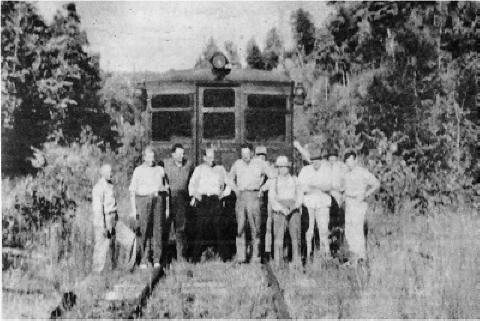 |
|
| Several local men pose at "the end of line" just before the steel rails were taken up and the Oneida and Western Railroad was closed. This photo was believed to have been taken by Howard H. Baker, Jr. | This is one of several pictures taken by I. O. "Sonny" Chitwood of outings to the O&W area in and around 1915-1916. The photos are in the collection of the Scott County Historical Society. |
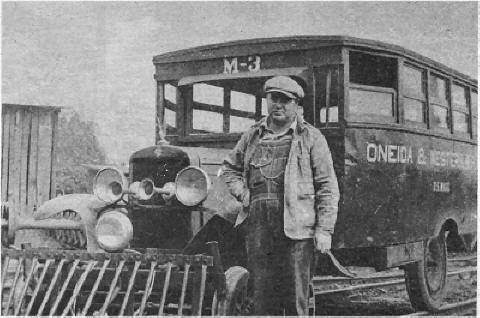 |
|
| Ziegler Beets in a photo taken with the M-3 bus in November 1936. | Engineer Milford Acres poses with Duard West. In background (with back to camera is Duard West’s son. |
Historian H. CLAY SMITH recorded: "After considerable debating and protest from the people of Fentress, Scott, Pickett and Cumberland counties, the case went before the courts in Crossville. The ruling was that the O&W was a losing road, and a permit was given to kill the charter. The steel was pulled for scrap, the engines were sold, and the mill went into the hands of H. H. CANNADA, his son, ROBERT, and B. B. CHITWOOD.
"The last train on the O&W ran in March, 1954, over 42 years ago.
"The office was sold to the Plateau Electric Cooperative for office space, and the right-of-way from Oneida to Verdun went to CARL COLEMAN, along with several acres of land in and around Oneida. COLEMAN sold some of the land to Jellico Grocery Company and other lots to Pennsylvania people, who later developed a coal tipple and crusher yard where the O&W ‘Y’ was.
"The right-of-way from Verdun to the Fentress County boundary was given to Scott County as a public road, and the same was done to Fentress County with the portion of the right-of-way within it."
Hopes were raised with local folk with the U.S. Army Corps of Engineers conducted a feasibility study for reopening the O&W Railroad. Talk was that it could be a railroad again; that it would be a hiking/bike trail; that it might be a trail for horseback riders, or maybe even a "rubber tire" trail that would allow elderly and physically challenged citizens the opportunity to view the rugged scenery of the O&W’s path through the Big South Fork National River and Recreation Area. It never came to be. The steel bridge that spans the Big South Fork River was reworked and floored, but the condition of the gravel and dirt roadbed pretty much depends on what time of year you travel on it. Freezes and thaws and spring rains all take their toll. Only four-wheel drive vehicles can get through to Jamestown today. The elements of nature are reclaiming the railroad that took laborers 8 long years of back breaking work, with dynamite, picks and shovels, and mule teams to carve out of the rugged wilderness region of the Big South Fork.
We, and future generations, will probably never hear the lonesome whistle of the train, smell the coal smoke and feel the cinders sprinkling on us from the soot, or see a locomotive rounding a curve on the O&W, but you can rest assured, it is very vivid in the memories of the survivors of the O&W.
|
|
FNB Chronicle, Vol. 8, No. 2 – Winter 1997
First National Bank
P.O. Box 4699
Oneida, TN 37841
(p1,4-12)
![]() This
page was created by
Timothy
N. West and is copyrighted by
him. All rights reserved.
This
page was created by
Timothy
N. West and is copyrighted by
him. All rights reserved.